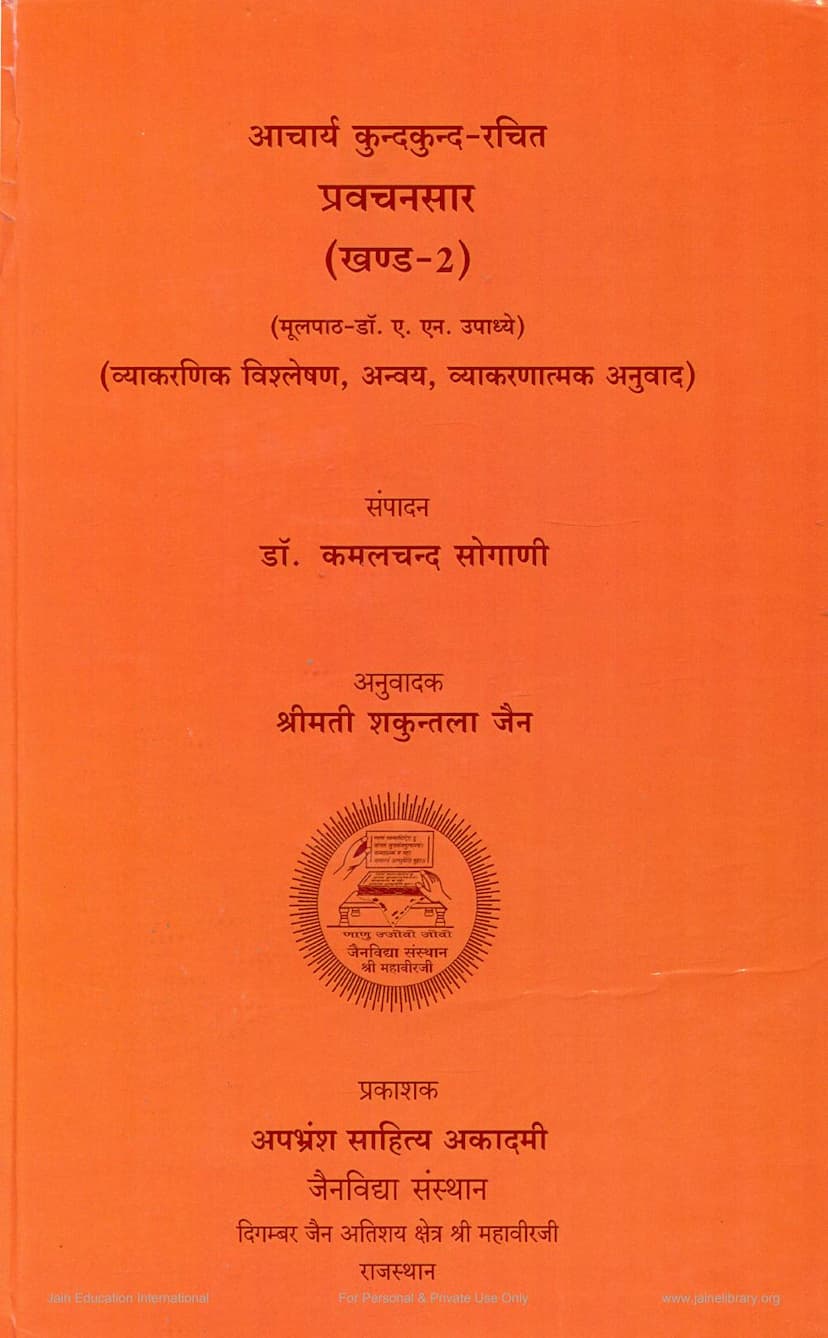Pravachansara Part 02
Added to library: September 2, 2025

Summary
This document is the second volume of the Hindi translation of the Jain text "Pravachansara" (प्रवचनसार), originally composed by Acharya Kundakunda. The translation and its scholarly apparatus were overseen by Dr. Kamalchand Sogani and translated by Mrs. Shakuntala Jain, with the original text edited by Dr. A. N. Upadhye. The book is published by Apbhramsa Sahitya Academy and Jainvidya Sansthan in Shri Mahavirji, Rajasthan.
This volume, specifically focusing on the "Geya Adhikara" (ज्ञेय-अधिकार), delves into the Jain philosophical concepts of Dravya (Substance/Essence) and Paryaya (Modes/Attributes).
Here's a comprehensive summary of the key themes and discussions presented in this volume:
Core Concepts:
- Dravya (Substance/Essence): The text emphasizes that substances (Dravya) are the fundamental reality. A substance is defined as that which possesses an essential nature (swabhava) that is eternal, unchanging, and is associated with its qualities (guna) and modes (paryaya). It is characterized by creation (utpad), destruction (vyay), and permanence (dhrauvya) within its own essential nature.
- Paryaya (Modes/Attributes): Paryayas are the transient changes or states that a substance undergoes. While they are temporary and arise from the substance, they are also seen as inherent to the substance. The text highlights that attachment to these modes leads to a distorted perspective ("parasamaya" - other-oriented view).
- Syadvada (Theory of Conditionality): The text implicitly explains the concept of substance and mode through different perspectives (nayas). It clarifies that from a substance-oriented perspective (dravyaarthika naya), a substance remains the same despite changes in its modes. From a mode-oriented perspective (paryayaarthika naya), the substance appears to change due to the distinctness of its modes. This leads to the concept of "avaktavya" (unspeakable/indescribable) when both perspectives are considered simultaneously.
Key Discussions and Elaborations:
- The Nature of Reality: The book begins by establishing that all worldly things are substances, and substances are fundamental to existence. It differentiates between substance and its existence (satta), explaining that while existence is a characteristic of substance, substance itself is not merely existence; they are distinct.
- The Process of Change (Utpad, Vyay, Dhrauvya): A core teaching is that every substance undergoes creation, destruction, and permanence simultaneously. These changes occur through its modes (paryayas). The permanence (dhrauvya) of the substance ensures that even though its modes change, the substance itself endures.
- The Six Substances: The text introduces the six fundamental substances of the Jain cosmos: Jiva (Soul), Pudgala (Matter), Dharma (Principle of Motion), Adharma (Principle of Rest), Akasha (Space), and Kala (Time). It briefly describes their nature and existence within and outside the universe (loka and aloka).
- Properties of Substances:
- Jiva (Soul): Characterized by consciousness (chetana/upayoga), it is formless, tasteless, odorless, intangible, and soundless.
- Pudgala (Matter): It is tangible and possesses properties like color, taste, smell, and touch. Sounds are considered modifications of matter aggregates.
- Dharma & Adharma: These are subtle, non-physical substances that provide the principles for motion and rest, respectively.
- Akasha (Space): It provides space for all substances and is all-pervading.
- Kala (Time): It is described as the cause of change and is understood through the duration of atomic movement.
- The Nature of Bonds and Karma: The text explains how the soul (Jiva) becomes entangled with matter (Pudgala) through karmic particles. The soul's involvement in worldly activities, desires, and aversion (raga-dwesha-moha) leads to the accumulation of karma, which in turn influences its rebirth and experiences.
- The Path to Liberation (Shuddhopayoga): The ultimate aim is to attain pure consciousness (Shuddhopayoga), which involves detaching from all worldly attachments, including the physical body, senses, and external objects. This is achieved through self-reflection, meditation, and the realization of the true nature of the soul as distinct from matter and its modifications.
- Distinction between Jiva and Ajiva: A significant portion of the text elaborates on the fundamental difference between the living (Jiva) and non-living (Ajiva) substances. The soul is defined by consciousness, while matter and other non-living substances are insentient.
- Body and Its Components: The various types of bodies (audarika, vaikriyika, taijasa, ahārika, and kārmana) are described as being composed of pudgala (matter).
- The Role of Qualities: The text discusses how qualities (guna) are inherent to substances and how they manifest as modes (paryaya). For example, the qualities of matter, like color and taste, are experienced as its modes.
- The Concept of Space and Time in Relation to Matter: The text details how matter exists in space and how time is the measure of change. The concept of a single-atom space is explained, capable of accommodating all atoms.
- The Soul's Purity: The book emphasizes that the soul, by its inherent nature, is pure consciousness. The impurities that bind it are karmic matter, which can be shed through spiritual discipline.
- The Importance of Right Faith and Conduct: The discussions on pure usage (shuddhopayoga) and the distinction between auspicious (shubha) and inauspicious (ashubha) intentions highlight the Jain emphasis on right faith (samyak darshan), right knowledge (samyak jnana), and right conduct (samyak charitra) as the path to liberation.
The volume includes extensive appendices, such as vocabulary lists (Sanskrit-Hindi and Prākrit-Hindi), verb conjugations, case endings, and a glossary of Sanskrit and Prākrit terms, making it a valuable resource for students and scholars of Jain philosophy and Prākrit literature.